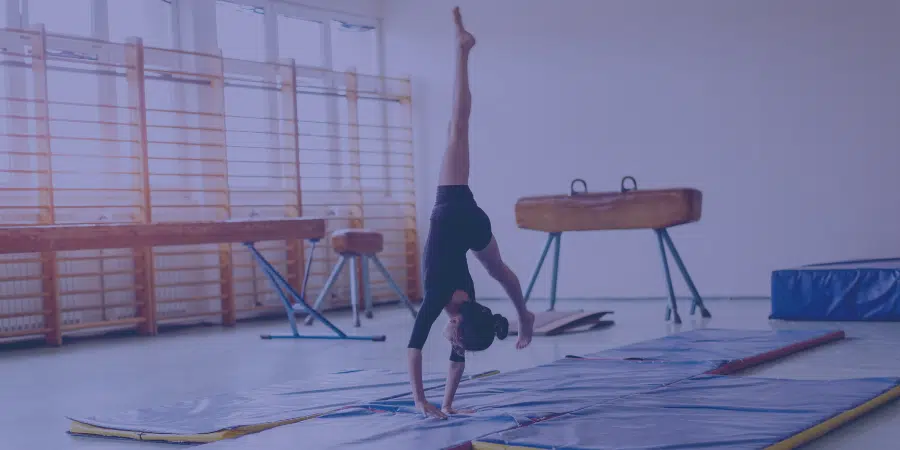Tumbling is a critical component of cheerleading and many students are eager to improve their skills in this area. If you’re starting a cheer gym or squad, tumbling classes are a must. Here are tips to roll out safe and effective cheerleading tumbling classes.
What Does A Tumbling Class Consist Of?
From stunts to dance numbers, cheerleaders put on quite a show. Tumbling is always a part of any winning routine.
So, what is tumbling? In short, it is known as floor gymnastics. Instead of using balance beams and bars, it’s a practice that doesn’t require any equipment or props. All you need is proper flooring!
For beginners, cheer tumbling classes explore the basics of tumbling. Think somersaults, cartwheels, and forward rolls. As students master the curriculum, they may be ready to embark on intermediate tumbling moves, including back handsprings and back tucks. At the most advanced level of tumbling, cheerleaders work to perform difficult maneuvers, such as full twisting layouts and aerials.

How To Set Up Your Cheer Tumbling Classes
If you’re ready to open a cheer gym and want to offer tumbling classes, it’s time to get planning!
Here are our tips to help you set up the best cheerleading tumbling classes for your students.
Structure your classes
While there are a variety of ways to structure your cheer tumbling classes, it helps to divide your students up by skill level. It can certainly be beneficial for safety reasons, but also for team building. Your students will enjoy being in a class where everyone is on the same page.
If you have the ability (and space) to have two separate groups practicing at the same time, you may be able to combine classes. For example, beginning/intermediate class or intermediate/advanced class combinations can work if they’re using different equipment.
In this scenario, you should have two instructors on hand to ensure both groups are getting the supervision and attention they need. This will help them continue to grow and excel and is also important for safety reasons.
You may also want to consider offering private tumbling classes at your gym. This option is popular with competitive cheerleaders who need to master specific skills. It’s also ideal for students who need to practice at their own pace, as well as students who are preparing for tryouts.
Host tryouts
Cheer tryouts are a great way to break students up into groups with similar levels of experience. As we mentioned before, this allows for safer and more enjoyable practices.
Explain to your students that this isn’t about competing against each other. It’s simply a way to determine the tumbling skills of each individual in order to place them in the correct class. For more information about how to host your own cheer tryouts, check out our list of tips here.
Ensure a safe space
When you’re starting a cheer gym, it’s important to remember that safety is always your top priority. According to Stanford Children’s Health, most cheerleading injuries happen during exercises involving gymnastic moves or tumbling.
USA Cheer (formerly AACCA) publishes safety rules and guidelines every year. You can find a full list of the 2020 guidelines here. In general:
- Only the appropriate surfaces and mats should be used for tumbling
- Hard and unbending supports or rough edges or surfaces must be properly covered
- Proper spotting should be used until students show that they have mastered the skills
- Structured stretching exercises and warm-up routines should be held before and after class
- A qualified and knowledgeable teacher or coach must always be on hand
USA Cheer also offers cheer safety & risk management online courses here.

Enforce the rules
While you can do everything in your power to create a safe gym, you will need your students to follow a few rules. Without every parent and student’s cooperation, you can’t guarantee safety.
Here are a few of the most important guidelines they should follow:
- Always practice in athletic shoes, not gymnastics slippers
- Never wear jewelry, including earrings, necklaces, bracelets, and rings
- Wear hair in a neat bun or ponytail to keep it out of the face
Consider posting a list of safety rules in a place where students and parents will see them every day. Strict enforcement is necessary in order to create a safe environment. Always remind your students to speak up if they’re feeling pain or discomfort during practice.
Spread the word
The great news about cheerleading tumbling classes is they are always in demand. If you’re looking to open a cheer gym, this type of class can boost enrollment and revenue because you have the opportunity to attract a variety of new students.
For example, cheerleaders in high school often need to master certain tumbling skills to be on the squad. At practice, there is little time for catering to these needs. They need to rehearse for upcoming competitions, pep rally events, and so much more. That’s where you come in! By offering private and group cheer tumbling classes, these students will have a place to get the instruction they need.
With this in mind, target your marketing efforts! Put up flyers in coffee shops and libraries surrounding local high schools. You may even consider reaching out to local coaches and explaining what you offer. This will help you spread the word about your new classes.
Starting Your Cheer Tumbling Classes
If you’re caught up in the day-to-day administrative tasks of running your business, it leaves little time for creativity. Studio Director is a studio management software that can manage and automate the administrative parts of your business so you can get back to doing what you love.
From accounting and billing to communication, Studio Director can keep your cheer gym running smoothly. Get ready to fly high by trying out a free trial today!


